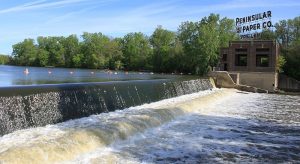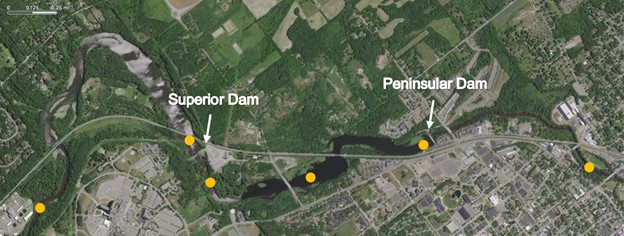Dams: Not as green as you might think!
Preliminary results from a recent EMU study indicate that dams on the Huron River may be hotspots for the release of greenhouse gases. Higher levels of both carbon dioxide and methane were measured in the impoundment above Peninsular Paper Dam compared to undammed areas of the river.
In the United States, there are more than 90,000 dams that serve a variety of purposes, including renewable power generation to combat climate change. Hydropower is one of the most common renewable energy sources, and thousands of hydropower dams are built worldwide each year. The decision to remove deteriorating dams, such as the Peninsular Dam, is often complicated. Dam removal can restore ecological habitat, but one argument against dam removal is that they can provide green energy. But hydroelectric dams are not as green as you might think. It turns out that damming is a source of greenhouse gas emissions.
Methane and Dams

Damming rivers can have numerous indirect and long-term environmental effects. One consequence of dams is that they collect a substantial amount of sediments and organic matter. Over time, impoundments behind dams can trap several feet of sediment and organic matter that would otherwise be released downstream. The captured organic sediment helps promote microbial activity behind dams.
Further, dams can reduce oxygen levels in the sediments, by slowing the flow of water and preventing efficient reoxygenation. Slower water flow and the increased organic matter can create anoxic zones. Over time, these low oxygen conditions promote methanogenesis, a processes in which microbes produce methane instead of the carbon dioxide that is produced in the presence of oxygen.
Methane production from dams is a growing environmental concern, because methane is a potent greenhouse gas. Methane can trap 28-36 times more heat in comparison to carbon dioxide. So, even though carbon dioxide is more abundant in the atmosphere, methane has a larger environmental impact per molecule.
Preliminary Findings

Our team at the Eastern Michigan University is studying the impact that dams have on greenhouse gas production. We are currently measuring dissolved methane at sites both upstream and downstream of the Peninsular Paper Dam (Pen Dam) (Note: the Peninsular Dam is not currently a functioning hydroelectric dam, but Superior Dam, located just upstream, is). We are also using chambers to measure the release of methane to the atmosphere.
Our preliminary findings indicate that dams on the Huron River could be hotspots for greenhouse gas production and emission. We found higher rates of methane and carbon dioxide production behind dams compared to flowing river sections of the water, supporting our hypothesis that the slower water flow and increased organic matter results in enhanced methanogenesis. This finding is consistent with previous studies examining larger dams in other parts of the world. Studies investigating methane release behind dams are still relatively scarce, and this research will provide a better understanding of the role of small dams in producing methane. Measuring methane emissions before removal of the dam will also allow for comparison to conditions after the dam is removed.
This research is ongoing, and we hope to share more on this topic soon. You can follow this project and more on HRWC’s Dams and Impoundments page.
-Jacob Fagerstrom

|
Jacob Fagerstrom is an undergraduate in Biology at Eastern Michigan University, working with Dr. Kristi Judd. His research interests include aquatic systems with a focus on the impact of humans on the environment. If you have any questions, feel free to contact Jacob at jfagerst@emich.edu. |



